In praise of the compost toilet, Lowimpact.org’s Sophie Paterson shares her love of compost loos, showcasing their versatility and practicality with a rundown of her favourites through the years.
First of all, a bit of a disclaimer: I’m a serious fan of compost toilets. So much so that a former colleague of mine wrote in my leaving card that whenever she uses a compost loo, she’ll think of me – a compliment, I’m sure!
A popular off-grid choice for allotments, community gardens and even golf courses, compost toilets are on the rise thanks to a burgeoning no-flush movement. Here’s a quick rundown of their environmental benefits, courtesy of the Lowimpact.org topic introduction.
- The solid waste is dealt with on site, and doesn’t have to be treated with chemicals in sewage farms, or end up in waterways, where it causes pollution and algal blooms
- Saves water – you don’t have to use one resource (pure drinking water) to flush away another (fertiliser)
- Organic matter is ultimately allowed to go back to the soil where it belongs, improving soil structure and nutrition
- No chemical cleaners or bleaches are used in the toilet
- They don’t contribute to the sewage sludge that is often dumped in landfill, or more controversially, put on to agricultural land uncomposted
- As long as the decomposition is aerobic, there will be no greenhouse gas emissions
- No electricity needed
- Very low resource use – no pipes are needed to transport waste to a sewage farm, and no truck needed to remove solid waste.
Not a bad list for starters. So where did my own love affair with compost toilets begin?
Back to basics
Having previously taken toilets somewhat for granted, a trip to the Hockerton Housing Project in 2007 gave me pause for thought. Amongst an impressive raft of sustainable infrastructure projects, compost toilets were not themselves a feature; instead, a rainwater harvesting system provided medium grade non-potable water for washing, bathing and toilet flushing, with the result that flushing was a luxury reserved for solids only.
“If it’s yellow, let it mellow. If it’s brown, flush it down.”, read the sign on their toilet wall. But what about not flushing at all? Here follows a selection of some of my favourite indoor and outdoor compost toilets to date.
Cosy, clean and comfortable
Is it possible to describe a toilet as cosy? Well, this one certainly was. Fast forward to 2014 and my very first – and all-time favourite – experience of a compost loo came courtesy of Carol Atkinson’s Straw Bale Cabin, near Howden in East Yorkshire (as featured here). Nestled into one corner, accompanied by a bag of sawdust, scoop, and instructions, it provided a comfortable, clean and entirely positive initiation into non-flush toileting, incorporated beautifully into what was otherwise a very conventional bathroom space.
Alas, I’m sad to say that it appears to be no more, having been replaced with a flushing toilet after a recent rennovation. Of course, compost loos can also be bought off-the-shelf with aesthetics closely resembling their conventional flushing counterparts, if this is an important consideration for you.
Pleasingly practical
Another compost loo success story for me was the practical yet stylish compost toilet block at OrganicLea, a vibrant workers’ co-op growing food on London’s edge in the Lea Valley. With plenty of space and all the necessary mod cons at hand, the addition of the aloe vera pot plants was a lovely little extra, as can be seen in the photo at the top of this page.
A poo with a view
A final favourite for me has to be the rather pleasingly-named Thunderbox mobile compost toilet, versatile units specifically designed to cater for events in off-grid settings. It comes courtesy of the Thunderbox Collective, who take their ‘poo miles’ seriously by supplying compost loos for hire within a 70 mile radius of their East Devon base, as well as constructing a variety of different models to order for distribution across the UK. In a suitably isolated setting on a Devon farm, it officially offered the best view I’ve yet had from a toilet.
Think you could love a compost loo too?
Perhaps you too are feeling inspired to consider a compost toilet in your life, or perhaps you need convincing that bit further? Here’s a rundown of resources from us here at Lowimpact.org to help.
- Our topic introduction sets out the what, why and how of all things compost toilets
- Read our most popular article about compost toilets ever, by Lesley Anderson
- Learn how to build a compost loo to suit you with our comprehensive online course led by compost toilet extraordinaire Cordelia Rowlatt of Vallis Veg
- Swot up with the Compost toilets: a practical DIY guide book by Dave Darby
- Ask our specialists a question by adding a comment at the bottom of this page
- Get crafty with The Loveliest Loo colouring book, a unique way to learn about compost loos courtesy of Mandy Burton

Last but not least, if you have your own favourite compost loo somewhere in the world, do let us know in a comment below.
Main image: author’s own.
 About the author
About the author
Sophie Paterson is a co-director at Lowimpact.org and NonCorporate.org, where she looks after promotion, social media, the blog and more. A graduate of the School of Natural Building, she lives in Totnes, Devon, having previously spent a year living and volunteering on a nearby smallholding.

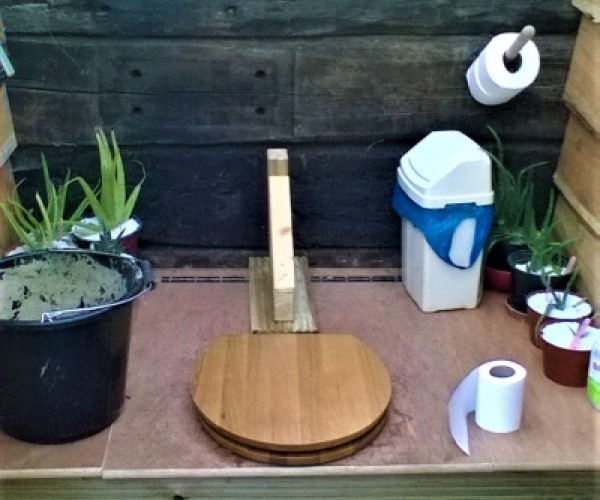
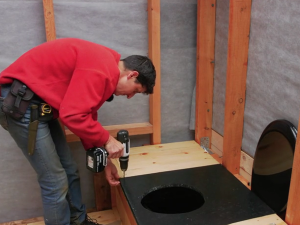
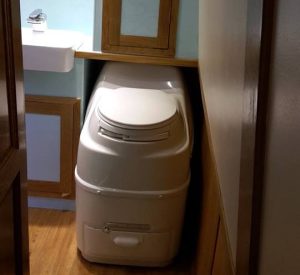
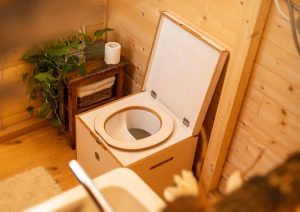
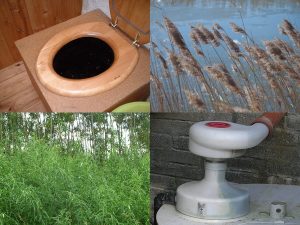
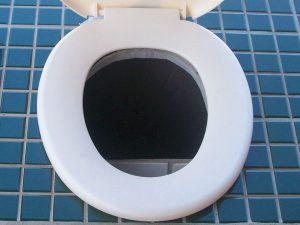
8 Comments
Dear Cordelia and Sophie
We wanted to let you know that our composting loos did not use 3,000 gallons of water last year. In just nine weeks of the campsite opening we had 750 guests and they were all introduced to the joys of sawdust and separators.
Marcus & Petra
Thank you, Sophie. In my experience, the single most important factor is to seperate liquids from solids – if you do this at source, then there is virtually no smell, and, for the person volunteered to undertake the disposal of solids, not a particularly unpleasant experience. The (close) second most important factor, in my opinion, is to make the use of the compost toilet a pleasurable experience – locate the composting toilet in a light and airy room, not a tiny closet, hidden away in a corner. Thirdly, you do need to insist that men sit down (and that ladies close the toilet seat behind them) – the seperator works equally well for both men and women.
At Sunflower Cohousing we constructed two purpose built small timber cabins, using the ‘Separett’ urine seperator (and no, I am not in any way affiliated to that company). They provide two versions – one with a conventional lid, and one with a ‘bung’ to close off the opening of the toilet itself – in my opinion, the former is aesthetically by far the best, although the latter is better at minimising any potential smells.
We collect solids in biodegradeable bags held inside a plastic container which fits hard up to the underside of the ‘platform’ housing the seat, and replace the bags once a week (or as required). Urine is mixed with water from the hand-washing facility and then drained to a sand filter bed (although one can also use urine in Permaculture applications).
We have had no issues or complaints whatsoever.
Hill Holt Wood indoor compost toilet – UK.
We had a mobile compost loo at our wedding – https://www.lowimpact.org/wp-content/uploads/35449863110_e738579e4c_w.jpg
Hello Sophie, thanks for your enthusiastic article ?
We have a compost loo, which we built in a section of our barn. I love it, it fulfills all requirements etc but, not everyone loves it, manly because it smells. We have a pee separator, but there is a pee smell. I rinse it through regularly, is there anything I can use to clear the smell?
Thanks,
Gus
Great article Sophie, and totally agree with Martin that urine separation is the key. We also use a vent to ensure air flow to assist composting in situ and dispell any smells Just to clarify the situation regarding the Thunderbox Collective. Although we only hire within 70 miles, as we take our carbon footprint seriously, we also construct a variety of different Thunderbox models to order and can distribute these anywhere in the UK.
@Marcus – Excellent! I think one-off (and more often than not first-time) experiences of compost toileting through camping and other holiday experiences are so important when it comes to their potential to spark thought and discussion back at home. Keep up the good work.
@Martin – Great to hear about all your positive experiences at Sunflower Cohousing. Definitely some top tips in there and I absolutely agree that its setting is just as important as the toilet itself, the more spacious, light and welcoming the better.
@Amanda – Thanks for sharing. I’m yet to visit there myself but do hope to one day. I’ll definitely be sure to check out the toilets if so!
@Dave – Brilliant and a lovely photo too.
@Gus – Glad you enjoyed the article and I’m sure you’re not alone with this question. I imagine our resident compost toilet specialists Patrick and Cordelia may have some answers on this front. If you post your comment at https://www.lowimpact.org/lowimpact-topic/compost-toilets/ they’ll able to share their wisdom with you.
@Rosie – Thanks, Rosie! I’ll add a clarification in to be sure this is clear in the article itself.
Hi folks, we are currently living off grid and implementing all things green and eco, working on the basis of constant improvement! Inspired even more by this article, as we put a dry toilet in our living space from the get go as there was no option for anything else. We use an all in one Blue Diamond unit bought commercially as it needed to replace the regular toilet space wise. Granted its a plastic lump but serves its purpose excellently and has given no problems to date. We also use biodegradable bags for solids to transport to another larger container, with urine collected and then poured in to a straw bale composter. We cant extol its virtues enough and make every effort to educate others.
Some good links in the article too, thanks!
Keep safe folks!!!
Neil